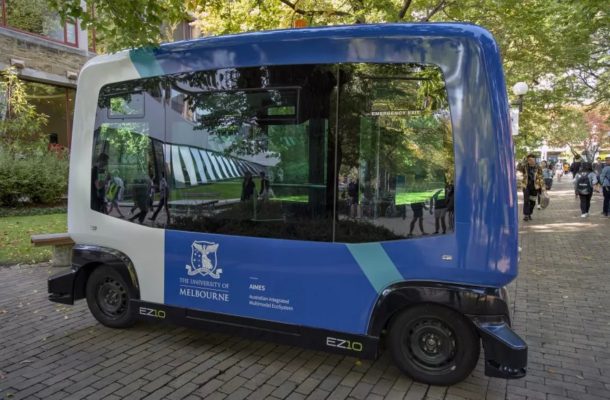New fixes for old traffic problems

Of course, this danger is not isolated to autonomous vehicles, with fatal car accidents sadly all too common around the world. Many argue that, despite early issues, autonomous vehicles will ultimately make our roads safer.
This is compelling, given the harm caused by our current system, where insensate machines routinely cause fatalities, injury, pollution, congestion and other costly inefficiencies.
But while, with more work, autonomous vehicles are part of the answer, at the University of Melbourne’s Transport Technology program we don’t think they are the whole solution. To really create a safer, cleaner, smarter transport future we need to look at the network as a whole.
That means cars, buses, trams, trucks, bicycles, and traffic signals for starters, but also the entire transport infrastructure, from the pavements and roads to the traffic lights.
Transport systems should be connected
While the rest of the world is fixated on self-driving cars, we have set ourselves a more ambitious vision.
We are developing overarching infrastructure that will allow allroad users (including vulnerable road users like pedestrians, cyclists and motorcyclists) – and all the machines that constitute a transport system (including autonomous vehicles) – to connect with each other, sense their greater environment, and have distributed and cooperative cognition.
This will allow road users to detect congestion hot spots faster and keep traffic flowing better. It will also make our roads safer – it has been estimated that connected transport can reduce the economic cost of road crashes by more than 90 per cent. And best of all, such a system can learn, improve and evolve.
We call this new technological capability ‘intelligent connectivity’.
It provides road users with information sensed, processed and distributed by machine-based intelligence built into the transport system. At the same time, this overarching intelligence allows us to also re-imagine the capabilities of self-driving vehicles.
The development of self-driving cars has attracted enormous investment globally and delivered technology that is performing well on uninterrupted freeways. The challenges start in mixed-use, urban environments.
But if we connect the car’s self-driving system into a self-sensing and connected environment we can start to address these challenges.
A living lab in the Melbourne CBD
These ideas are not idle speculation. In a six-square kilometre segment of inner-city Melbourne, we have worked with over 40 partners to establish the world’s first, and largest, ecosystem for the development of Vehicle-to-Vehicle (V2V), Vehicle-to-Vulnerable road users (V2P), and Vehicle-to-Infrastructure (V2I) communication systems.
We call it the Australian Integrated Multimodal EcoSystem (AIMES) and we think of it as a living laboratory to provide transport systems with new capabilities. The site features a complex mix of road types, road users, and traffic challenges, including tram routes, bicycle paths and popular pedestrian routes.
Throughout the network we have distributed sensors and that are providing data on what types of vehicles are where, how fast they’re travelling, and what’s nearby or impacting that area, like building work zones or accidents. This information is being used to develop algorithms that will eventually provide real-time traffic information, alternative routes and prevent crashes.
It’s about getting our transport options to talk to each other – and one day, that will include driverless vehicles.
To help us develop the best solutions to integrate autonomous vehicles with existing transport, we’ve partnered with EasyMile, and we are now home to our own, self-driving minibus, designed for low-speed urban environments.
Fitted with open platform technology, students and academics will have the opportunity to focus their research projects on real-life transport solutions to improve safety and sustainability and reduce congestion. As autonomous software advances and discoveries to improve safety and efficiency are made, our vehicle can be updated to reflect these improvements.
Our research is not about privileging one type of road user over others – be it self-driving cars or buses. Rather, it is about the efficiencies that are available when a system as a whole is brought into focus.
The development of a connected, sensate, or intelligent system overarching a transport network represents an inevitable evolution in our built environments. We live in the information age. All our technology is acquiring ever more of the characteristics of intelligent, environment-sensing organisms.
And yes, it will also mean the greater likelihood of self-driving vehicles operating more safely and efficiently than anywhere in the world.
Already, it is Melbourne, AIMES and our research partners that others are looking to for the transport solutions of the future.
This article was published by Pursuit.
Professor Majid Sarvi is the Chair of Transport Engineering at the Melbourne School of Engineering, the Program director of Transport Technologies and a director of the Australian Integrated Multimodal EcoSystem.












Alan Stevenson
April 14, 2018 at 4:21 pm
I can understand how one could cover a six square kilometer section of a city like Melbourne with sensors. However, please explain how users of AIMES would be able to easily access the data (you mention pedestrians). I feel the idea is great, if financially viable over a much greater area – say as far as St Kilda, Kew; the airport, etc.
We still have the problem of sorting out what decision a driverless vehicle would take in the event of an accident (protect the passengers; the majority of humans, etc)
Could you be a little more specific regarding your final concept for AIMES? Would it require buried cables in the roads, for example or CCTV?